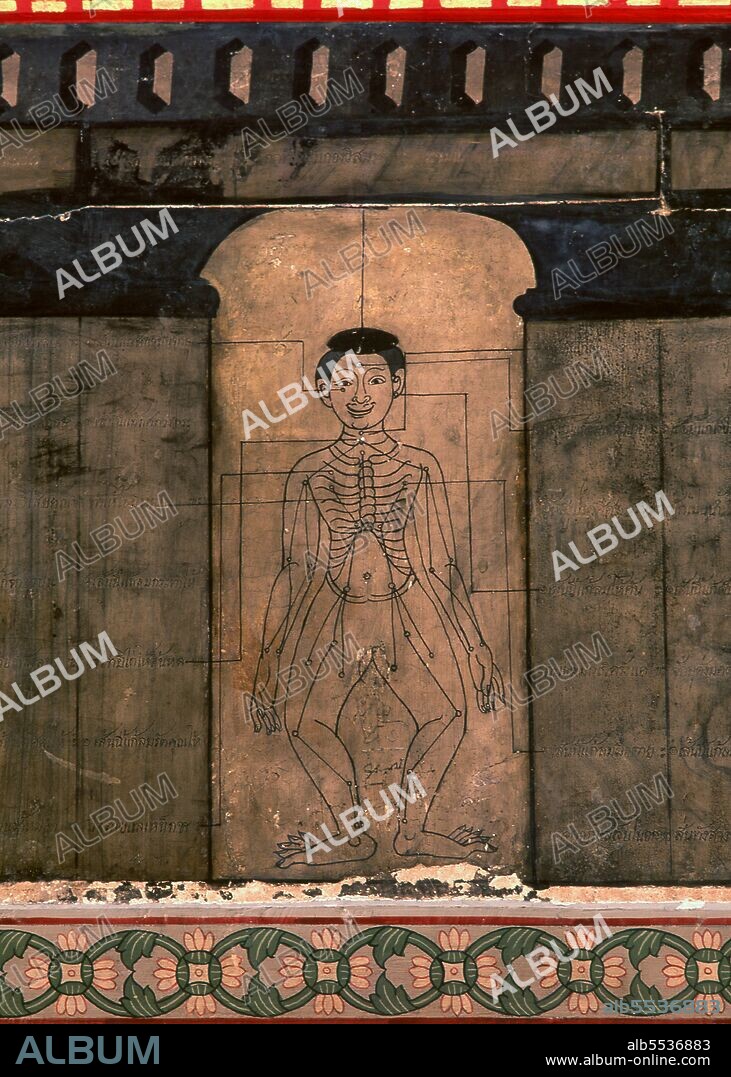alb5536883
Thailand: 19th century diagram placed during the reign of Rama III (1787-1851) showing the body's acupressure points, Wat Pho (Temple of the Reclining Buddha), Bangkok

|
Añadir a otro lightbox |
|
Añadir a otro lightbox |



¿Ya tienes cuenta? Iniciar sesión
¿No tienes cuenta? Regístrate
Compra esta imagen.
Selecciona el uso:

Título:
Thailand: 19th century diagram placed during the reign of Rama III (1787-1851) showing the body's acupressure points, Wat Pho (Temple of the Reclining Buddha), Bangkok
Descripción:
Traducción automática: El masaje tailandés, al igual que la medicina tradicional tailandesa en general, es una combinación de influencias de las esferas culturales y tradiciones médicas de la India, China y el sudeste asiático. El arte tal como se practica hoy en día es el producto de una síntesis del siglo XIX de varias tradiciones curativas de todo el reino. Incluso hoy en día, existe una variación considerable de una región a otra en Tailandia, y no hay una única rutina o marco teórico que sea universalmente aceptado entre los curanderos. Wat Pho, construido originalmente en el siglo XVI, es el templo más antiguo de Bangkok. El rey Rama I de la dinastía Chakri (1736-1809) reconstruyó el templo en la década de 1780. Oficialmente llamado Wat Phra Chetuphon, es uno de los templos budistas más conocidos de Bangkok y actualmente es una importante atracción turística, ubicada directamente al sur del Gran Palacio. Wat Pho es famoso por su Buda reclinado y es reconocido como el hogar del masaje tailandés tradicional.
Thai massage, like Traditional Thai Medicine more generally, is a combination of influences from Indian, Chinese, Southeast Asian cultural spheres and traditions of medicine. The art as it is practiced today is the product of a 19th century synthesis of various healing traditions from all over the kingdom. Even today, there is considerable variation from region to region across Thailand, and no single routine or theoretical framework is universally accepted among healers. Originally built in the 16th century, Wat Pho is Bangkok's oldest temple. King Rama I of the Chakri Dynasty (1736—1809) rebuilt the temple in the 1780s. Officially called Wat Phra Chetuphon, it is one of Bangkok's best known Buddhist temples and is nowadays a major tourist attraction, located directly to the south of the Grand Palace. Wat Pho is famed for its Reclining Buddha and renowned as the home of traditional Thai massage.
Crédito:
Album / Pictures From History/Universal Images Group
Autorizaciones:
Modelo: No - Propiedad: No
¿Preguntas relacionadas con los derechos?
¿Preguntas relacionadas con los derechos?
Tamaño imagen:
3556 x 4984 px | 50.7 MB
Tamaño impresión:
30.1 x 42.2 cm | 11.9 x 16.6 in (300 dpi)
 Pinterest
Pinterest Twitter
Twitter Facebook
Facebook Copiar enlace
Copiar enlace Email
Email
